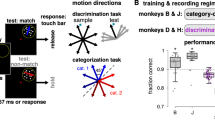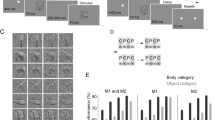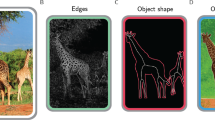Abstract
Categorization is a process by which the brain assigns meaning to sensory stimuli. Through experience, we learn to group stimuli into categories, such as ‘chair’, ‘table’ and ‘vehicle’, which are critical for rapidly and appropriately selecting behavioural responses1,2. Although much is known about the neural representation of simple visual stimulus features (for example, orientation, direction and colour), relatively little is known about how the brain learns and encodes the meaning of stimuli. We trained monkeys to classify 360° of visual motion directions into two discrete categories, and compared neuronal activity in the lateral intraparietal (LIP) and middle temporal (MT) areas, two interconnected brain regions3 known to be involved in visual motion processing4,5,6. Here we show that neurons in LIP—an area known to be centrally involved in visuo-spatial attention7,8,9, motor planning10,11,12,13 and decision-making14,15,16—robustly reflect the category of motion direction as a result of learning. The activity of LIP neurons encoded directions of motion according to their category membership, and that encoding shifted after the monkeys were retrained to group the same stimuli into two new categories. In contrast, neurons in area MT were strongly direction selective but carried little, if any, explicit category information. This indicates that LIP might be an important nexus for the transformation of visual direction selectivity to more abstract representations that encode the behavioural relevance, or meaning, of stimuli.
This is a preview of subscription content, access via your institution
Access options
Subscribe to this journal
Receive 51 print issues and online access
$199.00 per year
only $3.90 per issue
Buy this article
- Purchase on Springer Link
- Instant access to full article PDF
Prices may be subject to local taxes which are calculated during checkout




Similar content being viewed by others
References
Ashby, F. G. & Maddox, W. T. Human category learning. Annu. Rev. Psychol. 56, 149–178 (2005)
Barsalou, L. W. Cognitive Psychology: An Overview for Cognitive Scientists (Erlbaum, Hillsdale, New Jersey, 1992)
Lewis, J. W. & Van Essen, D. C. Corticocortical connections of visual, sensorimotor, and multimodal processing areas in the parietal lobe of the macaque monkey. J. Comp. Neurol. 428, 112–137 (2000)
Born, R. T. & Bradley, D. C. Structure and function of visual area MT. Annu. Rev. Neurosci. 28, 157–189 (2005)
Eskandar, E. N. & Assad, J. A. Dissociation of visual, motor and predictive signals in parietal cortex during visual guidance. Nature Neurosci. 2, 88–93 (1999)
Williams, Z. M., Elfar, J. C., Eskandar, E. N., Toth, L. J. & Assad, J. A. Parietal activity and the perceived direction of ambiguous apparent motion. Nature Neurosci. 6, 616–623 (2003)
Colby, C. L., Duhamel, J. R. & Goldberg, M. E. Visual, presaccadic, and cognitive activation of single neurons in monkey lateral intraparietal area. J. Neurophysiol. 76, 2841–2852 (1996)
Colby, C. L. & Goldberg, M. E. Space and attention in parietal cortex. Annu. Rev. Neurosci. 22, 319–349 (1999)
Bisley, J. W. & Goldberg, M. E. Neuronal activity in the lateral intraparietal area and spatial attention. Science 299, 81–86 (2003)
Snyder, L. H., Batista, A. P. & Andersen, R. A. Coding of intention in the posterior parietal cortex. Nature 386, 167–170 (1997)
Batista, A. P., Buneo, C. A., Snyder, L. H. & Andersen, R. A. Reach plans in eye-centered coordinates. Science 285, 257–260 (1999)
Buneo, C. A., Jarvis, M. R., Batista, A. P. & Andersen, R. A. Direct visuomotor transformations for reaching. Nature 416, 632–636 (2002)
Andersen, R. A. & Buneo, C. A. Intentional maps in posterior parietal cortex. Annu. Rev. Neurosci. 25, 189–220 (2002)
Platt, M. L. & Glimcher, P. W. Neural correlates of decision variables in parietal cortex. Nature 400, 233–238 (1999)
Shadlen, M. N. & Newsome, W. T. Neural basis of a perceptual decision in the parietal cortex (area LIP) of the rhesus monkey. J. Neurophysiol. 86, 1916–1936 (2001)
Huk, A. C. & Shadlen, M. N. Neural activity in macaque parietal cortex reflects temporal integration of visual motion signals during perceptual decision making. J. Neurosci. 25, 10420–10436 (2005)
Ghose, G. M. Learning in mammalian sensory cortex. Curr. Opin. Neurobiol. 14, 513–518 (2004)
Freedman, D. J., Riesenhuber, M., Poggio, T. & Miller, E. K. Categorical representation of visual stimuli in the primate prefrontal cortex. Science 291, 312–316 (2001)
Freedman, D. J., Riesenhuber, M., Poggio, T. & Miller, E. K. Visual categorization and the primate prefrontal cortex: neurophysiology and behavior. J. Neurophysiol. 88, 914–928 (2002)
Miller, E. K. & Cohen, J. D. An integrative theory of prefrontal cortex function. Annu. Rev. Neurosci. 24, 167–202 (2001)
Sigala, N. & Logothetis, N. K. Visual categorization shapes feature selectivity in the primate temporal cortex. Nature 415, 318–320 (2002)
Freedman, D. J., Riesenhuber, M., Poggio, T. & Miller, E. K. Experience-dependent sharpening of visual shape selectivity in inferior temporal cortex. Cereb. Cortex (in the press)
Vogels, R. Categorization of complex visual images by rhesus monkeys. Eur. J. Neurosci. 11, 1223–1238 (1999)
Freedman, D. J., Riesenhuber, M., Poggio, T. & Miller, E. K. A comparison of primate prefrontal and inferior temporal cortices during visual categorization. J. Neurosci. 23, 5235–5246 (2003)
Bisley, J. W., Krisna, B. S. & Goldberg, M. E. A rapid and precise on-response in posterior parietal cortex. J. Neurosci. 24, 1833–1838 (2004)
Toth, L. J. & Assad, J. A. Dynamic coding of behaviorally relevant stimuli in parietal cortex. Nature 415, 165–168 (2002)
Nieder, A. & Miller, E. K. A parieto-frontal network for visual numerical information in the monkey. Proc. Natl Acad. Sci. USA 101, 7457–7462 (2004)
Stoet, G. & Snyder, L. H. Single neurons in posterior parietal cortex (PPC) of monkeys encode cognitive set. Neuron 42, 1003–1012 (2004)
Acknowledgements
We thank J. Ditterich, A. Fanini, V. Ferrera, J. Fitzgerald, C. Freedman, T. Herrington, M. Histed, G. Maimon, E. Miller, C. Pack, C. Padoa-Schioppa, A. Seitz and J. Wallis for comments, help and discussions, and K. Irwin, T. Lafratta and J. LeBlanc for technical assistance. This work was supported by the National Eye Institute (NEI) and the McKnight Endowment Fund for Neuroscience, and a Kirschstein postdoctoral National Research Service Award from the NEI to D.J.F. Author Contributions D.J.F. performed all aspects of this study including the experimental design, data collection and analysis, and writing the manuscript. J.A.A. assisted in experimental design, data analysis and manuscript preparation.
Author information
Authors and Affiliations
Corresponding author
Ethics declarations
Competing interests
Reprints and permissions information is available at www.nature.com/reprints. The authors declare no competing financial interests.
Supplementary information
Supplementary Notes
This file contains Supplementary Methods and Supplementary Results. (DOC 44 kb)
Supplementary Figures
This file contains Supplementary Figures 1—8. (PDF 406 kb)
Rights and permissions
About this article
Cite this article
Freedman, D., Assad, J. Experience-dependent representation of visual categories in parietal cortex. Nature 443, 85–88 (2006). https://doi.org/10.1038/nature05078
Received:
Accepted:
Published:
Issue Date:
DOI: https://doi.org/10.1038/nature05078
This article is cited by
-
Category representation in primary visual cortex after visual perceptual learning
Cognitive Neurodynamics (2024)
-
A distributed and efficient population code of mixed selectivity neurons for flexible navigation decisions
Nature Communications (2023)
-
Abstract representations emerge naturally in neural networks trained to perform multiple tasks
Nature Communications (2023)
-
Distinct beta frequencies reflect categorical decisions
Nature Communications (2023)
-
Low-dimensional encoding of decisions in parietal cortex reflects long-term training history
Nature Communications (2023)
Comments
By submitting a comment you agree to abide by our Terms and Community Guidelines. If you find something abusive or that does not comply with our terms or guidelines please flag it as inappropriate.



